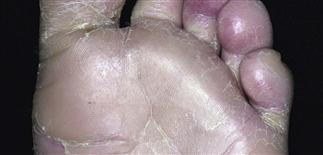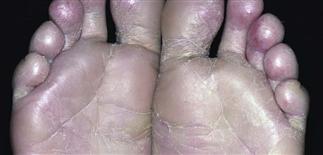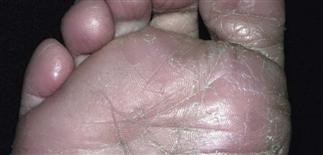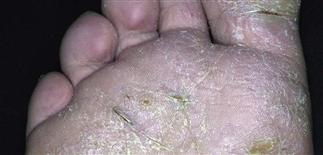Chapped, fissured feet

The feet have a chapped appearance, with scaling and fissures, which are often tender.

Both feet demonstrate affected skin that is more prominent on weight-bearing surfaces. Vesicles are typically absent, and a potassium hydroxide test is negative for fungal elements.

This example of chapped, fissured feet is notable for the increased skin lines and dry, cracked appearance of the great toe.

The chapped, fissured foot at its worst, with deep, painful fissures. A thick, bland emollient applied twice daily helps rehydrate the skin and heal the fissures.
DESCRIPTION
Findings include scaling, erythema, and tender fissuring of the plantar feet. Tendency for severe chapping is age-related; it is most common in prepubertal children but can occur in adults.
HISTORY
• Chapped, fissured feet are most common in early autumn, when the weather becomes cold and heavy socks and impermeable shoes or boots are worn. • Symptoms include soreness and pain, less commonly asymptomatic. • Mean age of onset is 7 years; mean age of remission is 14 years. • Symmetric involvement of the soles. Inflammation may be confined to just part of the soles. • Atopic dermatitis in children occurs mainly on the dorsal toes. Children with chapped, fissured feet complain of soreness and pain. • Cracks and fissures appear in cases of long duration. Pain becomes more intense than itching. • The key to improvement lies in frequent, heavy moisturization of the skin and prompt removal of moist footwear. • Differential diagnosis includes tinea pedis infection, allergic contact dermatitis, psoriasis.
PHYSICAL FINDINGS
• Skin on the plantar feet—especially the weight-bearing skin of the toes and metatarsal regions—is dry, erythematous, scaly, and fissured. Fissuring may be deep and very tender. • Chapping may extend to the sides of the toes. • Eventually, the entire sole may be involved.
TREATMENT
• Feet should be kept dry; avoid prolonged time in moist, occlusive shoes. Excessive sweating and occlusion often aggravate. • Apply thick emollient ointment (Aquaphor, petrolatum, Cetaphil, Aveeno cream) several times each day. • If the condition is pruritic, topical steroids provide some relief. Group II or III topical steroid ointments are applied twice a day, preferably with plastic wrap occlusion at bedtime, for 2–3 weeks. • A 15-min soak with tar oil (Balnetar) is followed by the application of a lubricating ointment or topical corticosteroid. • Preventive measures include changing into light leather shoes after removal of wet boots, alternating footwear to allow complete drying, and changing socks frequently if moist.







